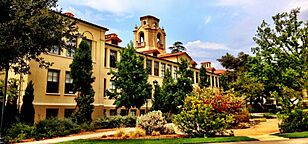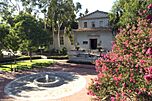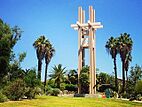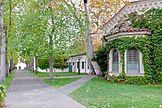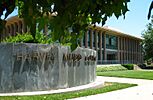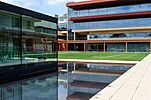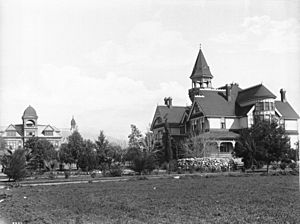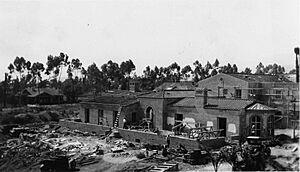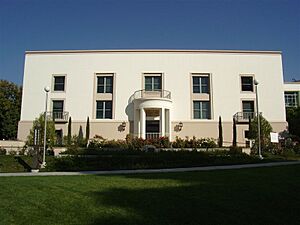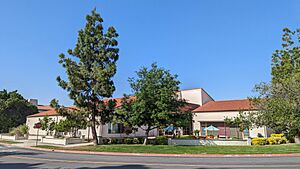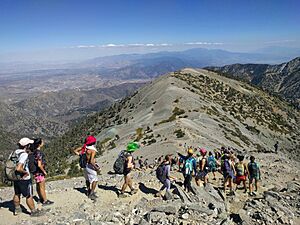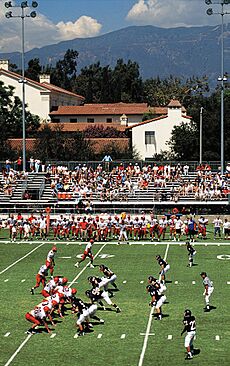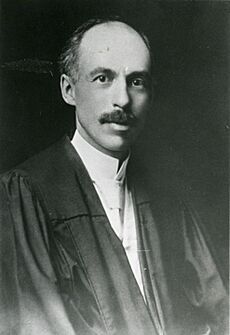Claremont Colleges facts for kids
|
(clockwise from top)
|
|
|
Former name
|
Claremont University Consortium (until 2017) |
|---|---|
| Type | Private consortium |
| Established | October 14, 1925 |
| Founder | James Blaisdell |
| Endowment | $27 million (2019) |
| Budget | $47 million (2019) |
| CEO | Stig Lanesskog |
| Students | About 8500 |
| Location |
,
,
United States
34°06′09″N 117°42′45″W / 34.10250°N 117.71250°W |
| Campus | Suburban, 546 acres (221 ha) |
| Nickname | Pomona-Pitzer Sagehens Claremont-Mudd-Scripps Stags and Athenas |
|
Sporting affiliations
|
NCAA Division III – SCIAC |
The Claremont Colleges are a special group of seven private colleges in Claremont, California. They are often called the 7Cs. A group of colleges working together like this is called a consortium. It's like having the best of both worlds: the small, personal feel of a small college and the amazing resources of a big university.
The consortium includes five colleges for undergraduate students (the 5Cs) and two schools for graduate students. The undergraduate colleges are Pomona College, Scripps College, Claremont McKenna College (CMC), Harvey Mudd College, and Pitzer College. The two graduate schools are Claremont Graduate University (CGU) and Keck Graduate Institute (KGI).
All the colleges have campuses right next to each other, covering about one square mile. This makes it easy for students to share things like a giant library, health services, and campus safety. Students can even take classes at the other colleges. Even though they work together, each college has its own unique personality and focus. Getting into the Claremont Colleges is very competitive.
Contents
The Seven Colleges
Undergraduate Colleges (The 5Cs)
These colleges are for students seeking their first four-year degree after high school.
- Pomona College (founded 1887): The oldest and largest of the 5Cs. It is for both men and women (coeducational) and offers classes in arts, humanities, and sciences.
- Scripps College (founded 1926): This is a women's college. It focuses on the humanities, which includes subjects like literature, art, and history.
- Claremont McKenna College (founded 1946): This college started as a school for men but became coeducational in 1976. It is known for subjects like political science, economics, and international relations.
- Harvey Mudd College (founded 1955): This college is a top school for engineering, mathematics, computer science, and other sciences. Students there also take classes in the humanities and social sciences.
- Pitzer College (founded 1963): Known for its focus on social justice and social sciences. It often tries new and creative ways of teaching.
Graduate Universities
These schools are for students who have already finished their undergraduate degree and want to continue their studies.
- Claremont Graduate University (founded 1925): Offers advanced degrees, like master's and doctoral degrees, in many different subjects.
- Keck Graduate Institute (founded 1997): A graduate school that focuses on science and medicine. It has schools for life science, pharmacy, and health sciences.
History of the Colleges
The story begins with Pomona College, which was founded in 1887. A group of people wanted to create a college like those in New England but on the West Coast.
By the 1920s, Pomona College was becoming very popular and was growing quickly. The president, James A. Blaisdell, had a choice: let the college get bigger and lose its small-school feel, or stop growing. He came up with a third idea. He suggested creating a group of different small colleges that would share resources, similar to the famous Oxford and Cambridge in England.
In 1925, the plan started to become a reality. A graduate school, now called Claremont Graduate University, was added. Then, in 1926, a woman named Ellen Browning Scripps founded Scripps College. She wanted to create a place where women could get a great education to help them in their careers and personal lives.
This new idea of a college consortium was exciting. People all over the country were interested in what was happening in Claremont.
More colleges joined over the years:
- Claremont McKenna College was founded in 1946 as a men's college.
- Harvey Mudd College was founded in 1955 to focus on science and engineering.
- Pitzer College joined in 1963 as a women's college focused on social sciences. It later began enrolling men in 1970.
- Keck Graduate Institute was the last to join in 1997, focusing on biomedical science.
To help all these colleges work together, a central organization called The Claremont Colleges Services (TCCS) was created. TCCS manages the shared resources for all the schools.
While each college is independent, they share many important facilities and programs. This cooperation is managed by The Claremont Colleges Services (TCCS).
Shared resources include:
- The Claremont Colleges Library: A huge library with over 3 million items, including books and digital resources.
- Tranquada Student Services Center: This building has the student health center, counseling services, and health education programs.
- Campus Safety: Officers who help keep all the campuses safe.
- Dining Halls: Students can eat at the dining halls on any of the 5C campuses.
- Bookstore: The Huntley Bookstore serves all the colleges.
Some academic departments are also shared. For example, students from any college can major in subjects like Women's Studies, Chicano Studies, or Media Studies through intercollegiate departments. There is also a shared science program for students at Scripps, Pitzer, and Claremont McKenna.
Clubs and Activities
With nearly 300 clubs and organizations, there is always something to do at the Claremont Colleges. Some clubs are for students at one specific college, while others are open to students from all seven.
- Student Media: The main student newspaper is The Student Life, which is the oldest college newspaper in Southern California. There is also a student-run radio station, KSPC.
- Outdoors Club: On the Loose (OTL) is the outing club for the 5Cs. It organizes outdoor trips for hiking, camping, and more.
- Dance and Theater: There are many dance groups, including a large ballroom dance company. The theater department puts on several plays each year.
- A Cappella: There are eight different a cappella singing groups on campus. They perform without any instruments, using only their voices.
Athletics
The colleges team up for sports.
- Pomona-Pitzer Sagehens: Students from Pomona College and Pitzer College compete together on these teams.
- Claremont-Mudd-Scripps Stags and Athenas: Students from Claremont McKenna College, Harvey Mudd College, and Scripps College compete together. The men's teams are called the Stags, and the women's teams are the Athenas.
All the teams compete in NCAA Division III in the Southern California Intercollegiate Athletic Conference (SCIAC). There are also many club and intramural sports for students who want to play just for fun.
Comparing the Undergraduate Colleges
Each of the five undergraduate colleges has its own character. The table below shows some differences between them.
| Pomona | Scripps | Claremont McKenna | Harvey Mudd | Pitzer | |
|---|---|---|---|---|---|
| Number of Students | 1,766 | 1,137 | 1,393 | 921 | 1,242 |
| Gender Ratio (Male:Female) | 50:50 | 0:100 | 52:48 | 52:48 | 46:54 |
| 2018 Acceptance Rate | 7.0% | 24.1% | 8.9% | 14.5% | 13.2% |
| Graduation Rate (within 6 years) | 93% | 88% | 90% | 96% | 83% |
| Student Retention Rate | 98% | 92% | 97% | 98% | 95% |
Notable People
Many famous and successful people have graduated from or worked at the Claremont Colleges. This includes artists, scientists, business leaders, and politicians. Each college has its own list of notable people.
- List of Pomona College people
- List of Claremont Graduate University people
- List of Scripps College people
- List of Claremont McKenna College people
- List of Harvey Mudd College people
- List of Pitzer College people
- List of Keck Graduate Institute people
The current CEO of The Claremont Colleges Services, who helps manage the consortium, is Stig Lanesskog.
Images for kids
-
Bernard Field Station, with the San Gabriel Mountains in the background


